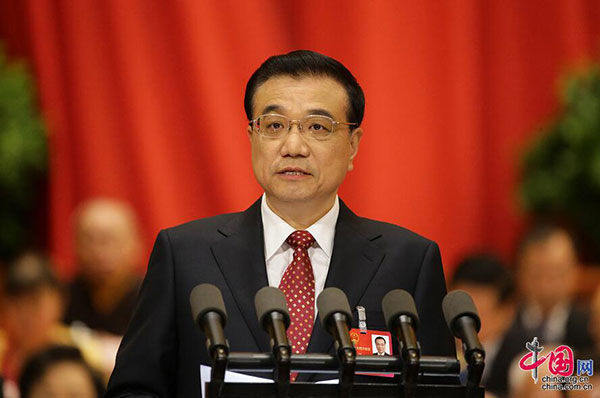Raising a Red Flag: China's economic future and cautious optimism
- By Kyle Calandra
 0 Comment(s)
0 Comment(s) Print
Print E-mail China.org.cn, March 7, 2016
E-mail China.org.cn, March 7, 2016
|
|
|
Premier Li Keqiang delivers the annual government work report at the opening meeting of the fourth plenary session of the 12th National People's Congress, which opened at 9 a.m. on March 5, 2016 at the Great Hall of the People, Beijing. [Photo/China.org.cn] |
Beijing, always the beating heart of China's political and economic dragon, is currently playing host to what are known collectively as the "two sessions." China's top legislature, the National People's Congress (NPC), and top political advisory body, the Chinese People's Political Consultative Conference, meet in annual session from early to mid-March.
Roughly 3,000 national legislators are gathering at the 4th session of the 12th NPC to vote on China's 13th Five Year Plan, with more than 2,000 members of the advisory body discussing the nation's leading economic, political and social concerns.
This year, the sessions are being held against the backdrop of rising concerns regarding China's recent economic transition toward what economists and policymakers have labeled the "new normal."
Last March, Premier Li Keqiang said the country would lower its 2015 economic growth target to "around 7 percent" in light of what he referred to as "formidable" difficulties.
Released by the government in mid-January of this year, official statistics for 2015 revealed that the economy grew 6.9 percent, in line with forecasts. While the world's economies remain mired by the unpleasant realities of recession, China's growth rate, though enviable, is the country's lowest in 25 years.
If the global economy can be described as a "moveable feast," both pundits and policymakers have been left wondering if China's once fierce economic dragon has lost its appetite.
Highly scrutinized by the international community, China is currently undergoing major economic structural reform, transitioning from an economy heavily reliant on high profile investment projects to a focus on supply-side economics and consumer spending.
According to Ulises Granados, a professor of international relations at Mexico Autonomous Institute of Technology, "The choice of supply-side structural reform indicates that China does not intend to employ traditional stimulus measures. [Instead, it] is trying to find a new path for sustainable economic development."
Widely regarded as a kind of ongoing economic experiment, concerns over China's supply-side reform have agitated global markets and highlighted investor's waning confidence, with billionaire George Soros adamantly predicting China's "hard landing" a near certainty.
According to a government work report made available to the media on March 5, China's top officials have targeted economic growth of 6.5 to 7 percent in 2016, and an average annual growth rate of at least 6.5 percent through to 2020.







Go to Forum >>0 Comment(s)